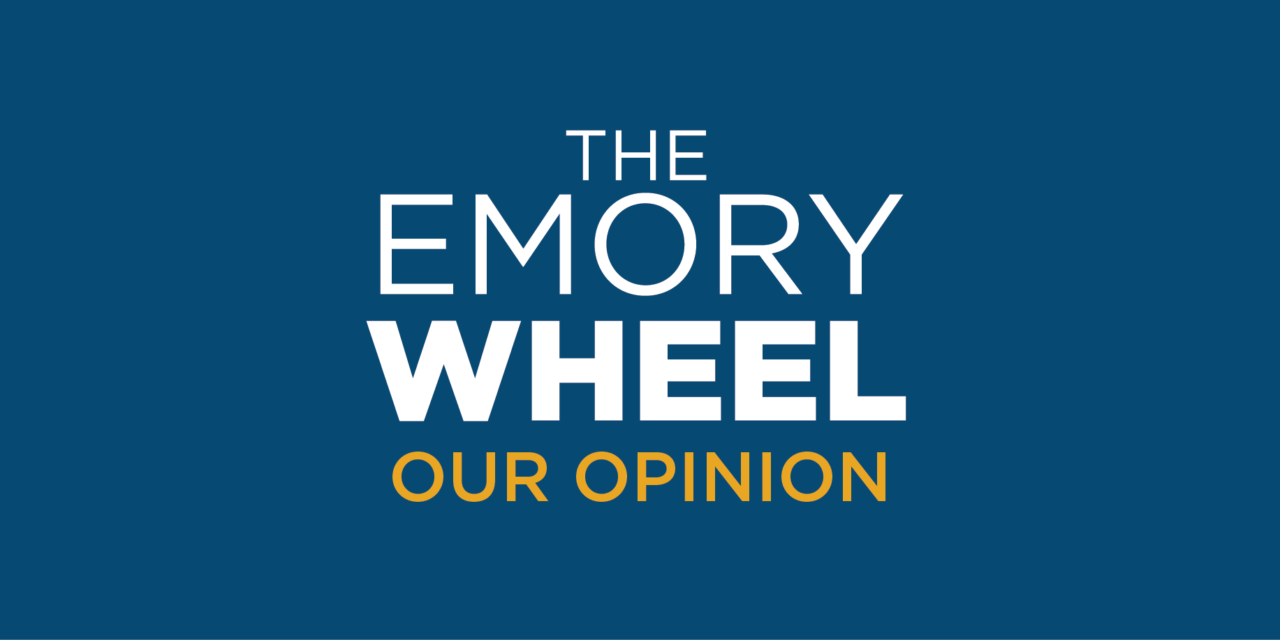Emory’s mission statement more or less states that it strives to create an environment where new students feel accepted, no matter who they are or where they come from. First-year students participate in Creating Emory, which encourages students to embrace diversity and condemns bigotry and harmful language to ensure that no student feels isolated because of their race, gender or sexual orientation. But a fundamental part of our identity is hidden behind Emory’s marble walls when we arrive on campus: our socioeconomic class.
We at the Wheel believe that the atmosphere surrounding class at Emory is uncomfortable and that the community is unsettlingly silent on the topic. The predominant assumption on campus — and throughout Atlanta — is that Emory’s students are on the upper end of the socioeconomic spectrum. Why? Because Emory’s recent drive in 2007 to provide expansive, need-based financial aid, Emory Advantage, has yet to wash away its history of being an elite institution. And this assumption is problematic, because it leads to feelings of alienation for those who represent the counterexample of Emory’s upper-class stereotype.
In order to come to terms with the realization that everybody around them assumes they are rich, lower-income students tend to face one of two options.
They can hide their background from their peers. This can be a self-alienating process, for it involves avoiding shame through deception, which is itself an isolating act. Worse, if they are successful in hiding the reality of their socioeconomic background in the elite environment at Emory, they may become alienated from the their lives back home. In a New York Times article, a son of Mexican immigrants recalled feeling arrogant as he explained immigration history to his uncles, who were discussing not being able to visit Mexico because they were undocumented. While Emory has made strides in accepting students of all classes, it still very much resembles an elite community.
The alternative option is to be honest and forthcoming about it. We are glad if there are those who can have an Emory experience unfazed by class assumptions. But this is not possible for everybody.
Leaving home and going to college can be hard for anyone, but it’s especially hard for students without an abundance of financial resources. Textbooks, dorm supplies, clothing and food and other essentials for college can be a major source of stress for students from low-income families. Students who rely on work study jobs have to set time aside from their already crowded schedule but still can’t close the gap between them and their peers. Breaks become problematic for students who can’t afford to leave campus because the DUC closes, and meal swipes become worthless. College is hard; college is nearly impossible without money.
This applies to poor college students in general, but here at Emory the lack of class awareness makes it seem as though the starving college student doesn’t exist here. The numbers, however, say otherwise. Emory’s track record in providing financial aid to lower income students is far from dismal, after all. Emory has a higher percentage of Pell Grants than many other peer institutions. The average need-based scholarship is $36,000 per year.
However, given Emory’s history as an elite institution, the culture here excludes poor students and makes it harder for them to get by socially. For example, students may feel isolated when their friends go out to eat, and they can’t afford to join them. However, awareness is imperative, because students unknowingly have the power to exclude their peers without thinking twice.
We have realized that the atmosphere surrounding class at Emory is awkward, and there is little talk about it. This makes it even harder for students struggling financially to discuss their situations with their peers. The community at Emory just isn’t comfortable with thinking about class, and we believe there needs to be a change.
Creating Emory discusses these hard to talk about subjects, but does not meaningfully address class differences and difficulties. Emory takes pride in its diverse student body, and we at the Wheel believe that it should be proud to have students from multiple socioeconomic backgrounds. Emory already does a fantastic job at giving poor students the opportunity to attend such a prestigious institution, but they shouldn’t stop there. Right now poor students are given the means to attend, but then they are left to figure out how to live in a rich kid’s world.
We believe that Emory should be doing more to raise awareness of the socioeconomic diversity among the student body and seek to disprove the assumption that only wealthy students attend Emory.
Along with supporting an environment that is friendlier to financially disadvantaged students, we must seek to provide funds for students who have trouble affording textbooks and dorm supplies once they arrive on campus. We would support any group or action committee for lower-income or first generation college students. We think that the topic should also be addressed more thoroughly in Creating Emory.
We acknowledge that this task is neither easy to address nor easily resolvable. It is a task that takes full community engagement and investment, from the very top — such as the administration — to the very bottom — such as in interpersonal relationships. However, we have faith that the Emory community has the capacity to step up and make good on its commitment to fostering a safe space for everyone of all backgrounds.
The above staff editorial represents the majority opinion of the Wheel’s editorial board.
The Emory Wheel was founded in 1919 and is currently the only independent, student-run newspaper of Emory University. The Wheel publishes weekly on Wednesdays during the academic year, except during University holidays and scheduled publication intermissions.
The Wheel is financially and editorially independent from the University. All of its content is generated by the Wheel’s more than 100 student staff members and contributing writers, and its printing costs are covered by profits from self-generated advertising sales.








I’m glad you decided to bring attention to this issue, but this article pisses me off for a number of reasons.
1. This shouldn’t be a revelation. I get that maybe it is for the majority here (Mom and Dad are paying for most, if not all, of your undergraduate education), but it shouldn’t be.
2. Don’t call us “poor.” You know how that comes across, right? That’s worse than when SGA decided to fund Walmart shuttles for the “less fortunate” students.
3. If you’re going to draw attention to a social issue, do it in a way that doesn’t come across like you’re trying to help a charity. There’s a way to foster a more inclusive atmosphere without being condescending or acting like you’re getting community service hours for it.
I agree with this wholly. It’s awesome that class issues are being addressed AT ALL (since it’s usually ignored), but calling me (or anyone else in a similar situation) “poor” is inherently condescending. Again, the effort is appreciated, but I’m a person, not an object for you to deign talking about.
Pros – breaking the unsettling silence
“honest and forthcoming” => vulnerability
cons – they could have chosen better examples
To give ourselves a break – this is something we don’t talk about period, not just at Emory. We’re afraid to be called Marxists, or worse, socialists.
There is a way in which the article simplifies the issue. But give the Wheel a break, it was their first editorial on the issue. It’s true, they are behind on the conversation – UPenn and Yale, for example, have been looking at the issue for at least two years now
http://yaledailynews.com/magazine/2013/11/07/we-dont-talk-about-it/
This is a broader conversation and if you are interested in more nuanced reporting I have found these articles a good starting place:
The Boston Globe, “What is it like to be poor at an Ivy League school?”
https://www.bostonglobe.com/magazine/2015/04/09/what-like-poor-ivy-league-school/xPtql5uzDb6r9AUFER8R0O/story.html
The New York Times
“Why Poor Students Struggle”
http://www.nytimes.com/2014/09/22/opinion/why-poor-students-struggle.html?hp&action=click&pgtype=Homepage&module=c-column-top-span-region®ion=c-column-top-span-region&WT.nav=c-column-top-span-region&_r=0
&
“For Poor, Leap to College Often Ends in a Hard Fall”
http://www.nytimes.com/2012/12/23/education/poor-students-struggle-as-class-plays-a-greater-role-in-success.html
Peer Financial Counseling the “Invisible Barriers” social justice talk put on by Volunteer Emory. Don’t get me wrong – these cannot be used as excuses for complacency or continued silence. Campus Life recentyl
momentum.
Thanks, Peter, for such a thorough and informative post! I agree that we should first look to existing structures, and I’d be particularly interested in finding ways within those structures/organizations/activities to not only identify the obstacles faced by lower-income students, but also to celebrate their resilience. I, too, am eager to continue this conversation. Anyone should feel free to contact me on facebook or by email (dorthie.cross@emory.edu). And to echo Peter, you really are not alone.
I think it’s great that the Emory Wheel is openly discussing what is often a very uncomfortable topic, particularly within elite institutions such as ours. I agree with a previous poster that some of the language may be problematic, but I hope that the message of the article is not lost in a discussion of language. It takes courage to bring these kinds of topics forward, and if we are too afraid of criticism, we may be more hesitant to talk about it. Nevertheless, I think the previous poster has another good point regarding the Walmart shuttles (I was not previously aware of these). Part of the problem may be the lack of communication between two cultures of students–those with ample access to resources and those struggling for resources. If the high-resource students drive the conversation alone, recommendations for changes may not be relevant to the students to which they are directed, even if the motivations are good. Thus, students coming from lower-resource backgrounds should consider joining together to contribute to that conversation–perhaps through a new or existing campus organization to promote success among these students. It could include undergraduate and graduate students, postdocs, residents, and faculty who are experiencing/have overcome/are still struggling with the kinds of disadvantage that comes with growing up in a lower-resource family or community. We could work as a group to 1) identify existing resources at Emory and in the broader community, 2) identify unmet needs (both economic and social), and 3) promote a sense of community, belonging, and pride within an amazing group of students.